Grizzly bears are large, ferocious members of the Ursus family, which are native to North America. Where do grizzly bears live? Here is your guide to the grizzly bear population by state.
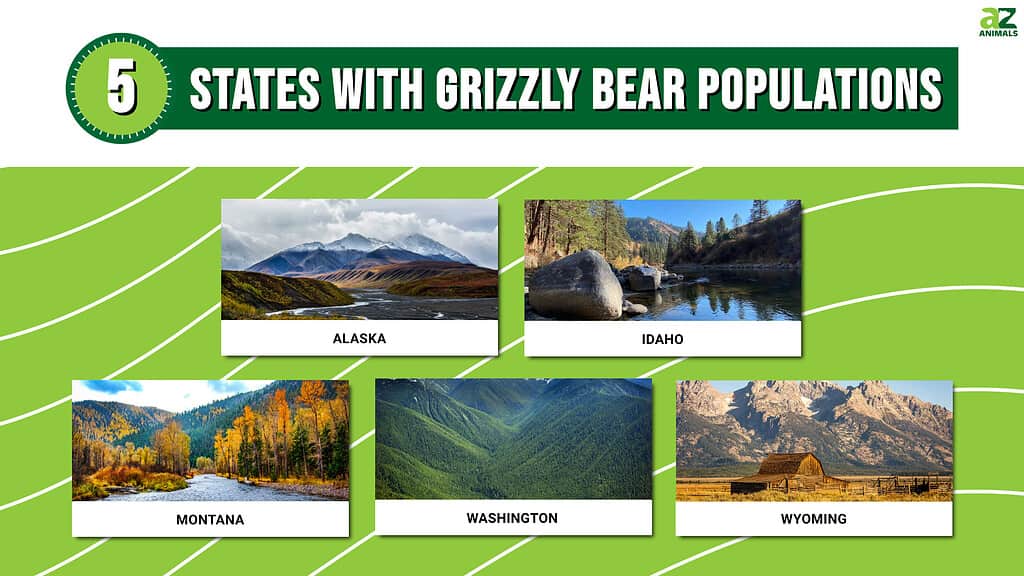
Meet the Grizzly Bear
The grizzly bear (Ursus arctos horribilis) is also known as the North American brown bear. It is a big bear that is native to North America. The grizzly is known for its large size and aggressive behavior. In terms of size, a male grizzly stands over 7 feet tall and can weigh more than 500 pounds.
Unlike the black bear, the grizzly is not shy around humans. Although a grizzly won’t go out of its way to attack humans, it can be dangerous to meet one in the wild. In March 2022, a hiker in Montana was killed by grizzlies. Since 2020, eight people have been killed by grizzlies in the Yellowstone region. Conservationists believe that attacks have increased because more people have moved into rural areas near bear habitats.
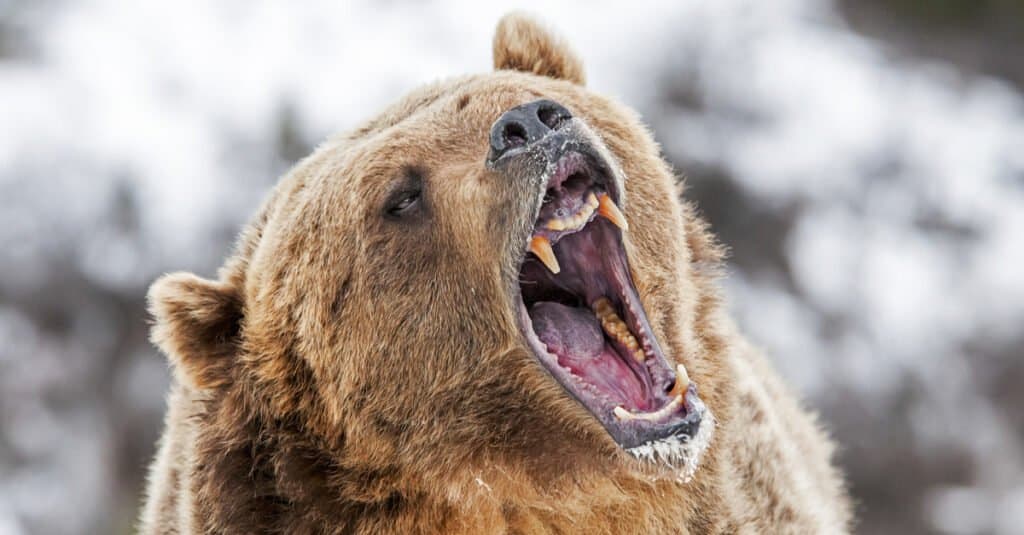
Grizzly bears feast on everything from salmon and trout to large animals such as moose and elk.
©Scott E Read/Shutterstock.com
Where do grizzly bears live?
Although they were once widespread throughout most of the western range of the United States, grizzlies now live in just a few northwestern regions. Like black bears, they were hunted almost to extinction in some areas, and they are still threatened by habitat loss. Grizzlies are protected under the Endangered Species Act and many state wildlife protection laws.
Conservationists note that the grizzlies living in the U.S. are thriving. They have regular breeding rates, and their populations appear to be increasing. Conservation efforts have increased grizzly populations in all these states, and grizzlies have set up breeding populations beyond their conservation areas.
Where do grizzly bears live? Until 2016, there were six ecosystems set aside for grizzlies in the United States:
- Greater Yellowstone National Park
- Northern Continental Divide
- Cabinet-Yaak Ecosystem
- North Cascades
- Bitterroot.
In 2016, the Greater Yellowstone area was delisted because bear populations were stable there.
What do grizzly bears eat?
Like all bears, they are omnivores who eat what is readily available in their environment. Grizzlies eat up to 90 pounds of food a day. They have an extremely varied diet that can include:
- Mammals, including badgers, rabbits, and foxes
- Rodents
- Insects
- Fruits
- Honey
- Elk’s calves
- Trout
- Salmon
- Pine nuts
- Grasses
- Roots
- Berries
- Apples
- Corn.
Lifespan: How long do grizzly bears live?
The grizzly bear is built for longevity. The average grizzly bear lives 20-25 years. Some grizzlies can even survive for 35 years in the wild. In captivity, they can live over 30 years.
What is their population in the United States?
There are an estimated 55,000 grizzly bears in North America. Where do grizzly bears live in the United States? The grizzly population the United States is limited to Alaska, Idaho, Montana, Washington, and Wyoming. There are about 21,000 grizzlies in Canada.
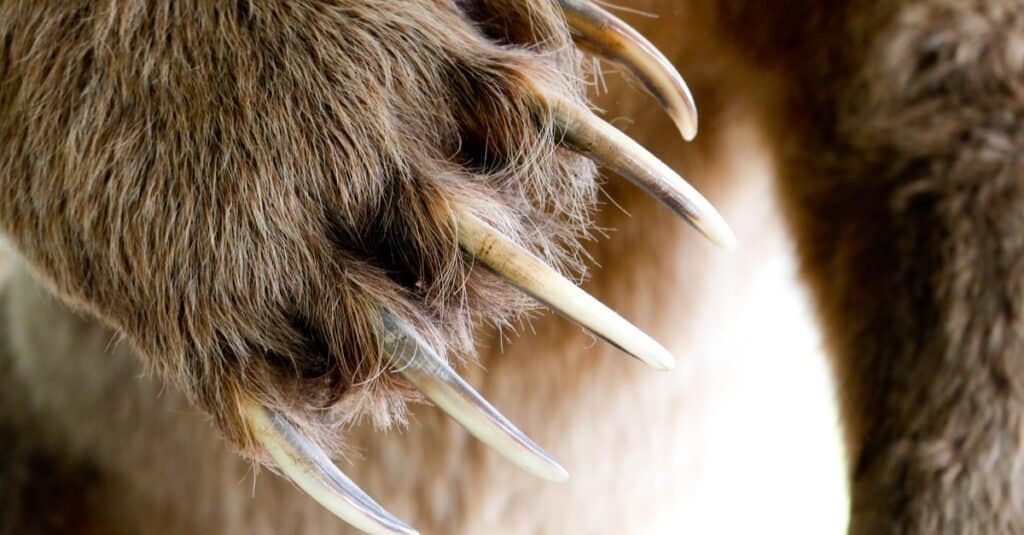
Grizzly bear paws have incredibly long claws!
©TheWonderWays/Shutterstock.com
Please note that tracking wildlife populations is not an exact science. This is especially the case when estimating populations of animals with extensive ranges, like bears. It’s also important to note that some bear populations involve several states, for instance, many bears live in or near Yellowstone National Park, which extends across Idaho, Wyoming, and Montana.
For our population numbers, we relied on official numbers from each state’s Department of Fish and Game, Department of Natural Resources, or another source.
GRIZZLY BEAR POPULATION BY STATE
Alaska: 30,000

©Robert Frashure/Shutterstock.com
Alaska is rightly known as bear country. It is the only state in the country where all three species of North American bears live. Besides its thriving populations of grizzlies and black bears, it is also home to polar bears. Alaska is also home to Kodiak bears, which are a subspecies of brown bears endemic to the Kodiak Archipelago.
With its rugged forests and unspoiled tracts of land, it’s natural that Alaska would be home to many grizzlies. The state has an estimated 30,000 grizzlies. It is home to 98% of the U.S. population of brown bears and 70% of the entire North American population.
Because of this, the state Department of Fish and Game says, “Alaska has a special responsibility to this magnificent animal.” The state has set aside conservation areas for the bears and issues a limited number of bear hunting licenses to control bear populations. Alaska is the only state where brown bears are not considered endangered.
Idaho: 80 to 100
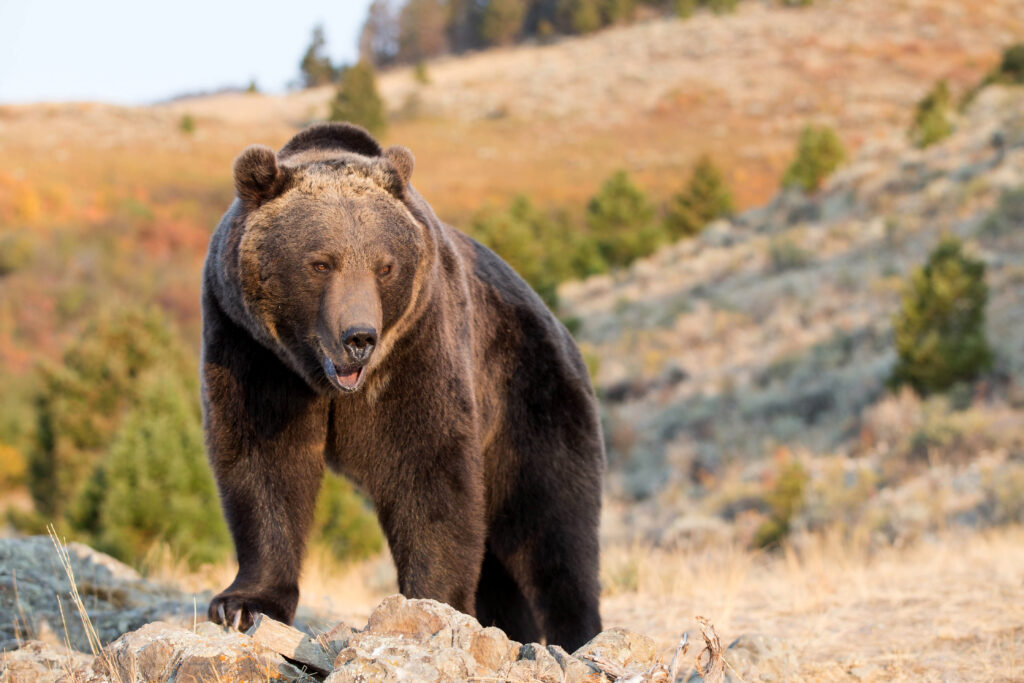
Grizzly bears are a subspecies of brown bears.
©Dennis W Donohue/Shutterstock.com
Grizzlies once lived all over the state, but now there are only a few who live in the northern and eastern parts of the state. Two conservation areas are home to about 40 bears. They have special conservation areas close to Yellowstone National Park. Idaho classes grizzlies as a threatened species. It is illegal to hunt, take, or own them.
In 2016, the Greater Yellowstone Ecosystem Population was removed from the threatened list because brown bears are thriving in that zone. They now have a healthy breeding population in that ecosystem, which includes Idaho and Wyoming. Grizzlies also live in the Bitterroot Ecosystem Recovery Zone and the Selkirk Mountains of northern Idaho.
Montana: 1,800 to 2,000
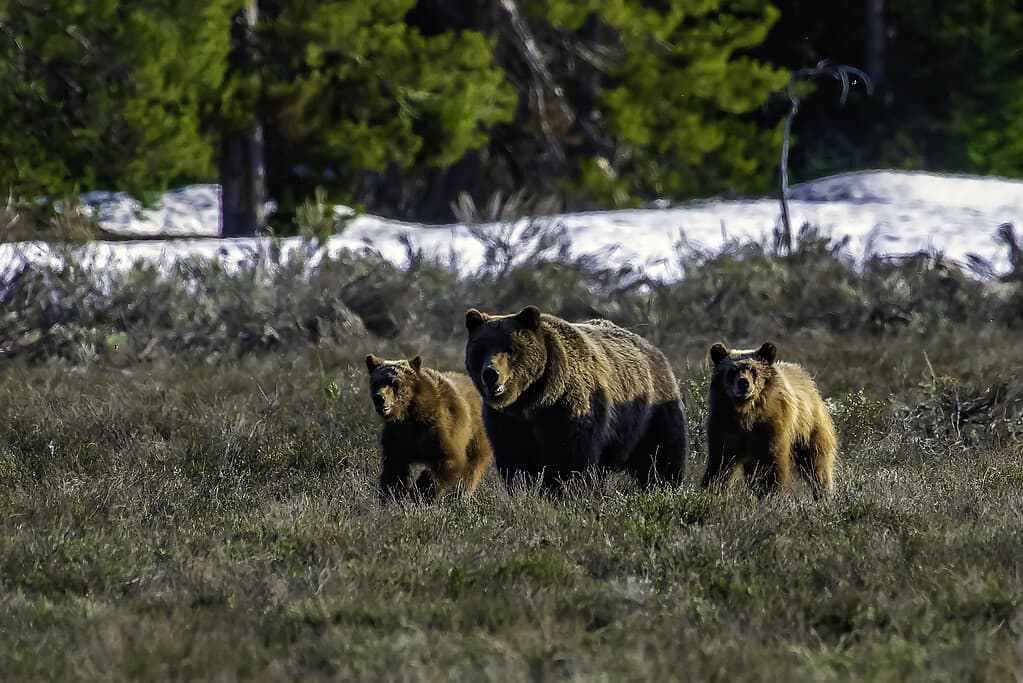
A grizzly mother and cubs were running to escape a male grizzly that they feared in the woods behind them.
©John Morrison/iStock / Getty Images Plus via Getty Images
Montana has an estimated 1,800 to 2,000 brown bears. Most bears in the state are part of the Northern Continental Divide Ecosystem.
Montana’s Fish and Game Department says the state has been at the forefront of grizzly bear protection and recovery. Montana abolished baiting and the use of dogs to hunt bears in 1921, listed bears as a managed hunting species in 1923, and outlawed the killing of cubs or females with cubs in 1947. In 1983, Montana chose the grizzly as its official state animal. Today, the state is home to more brown bears than any state except Alaska.
Washington: 500

©Kelp Grizzly Photography/Shutterstock.com
Like many other states, Washington once had an abundant brown bear population. Conservation efforts have focused on protecting the small number of remaining bears. Grizzly bears are an endangered species in Washington, but two populations remain in the Selkirk Mountains and areas near the Canadian border. Killing a grizzly bear can result in costly fines and penalties. To protect grizzly bears from human activities such as hunting, the Washington Department of Fish and Wildlife (WDFW) is responsible for supporting wildlife conservation, responding to conflicts, and managing public safety concerns.
Wyoming: 600
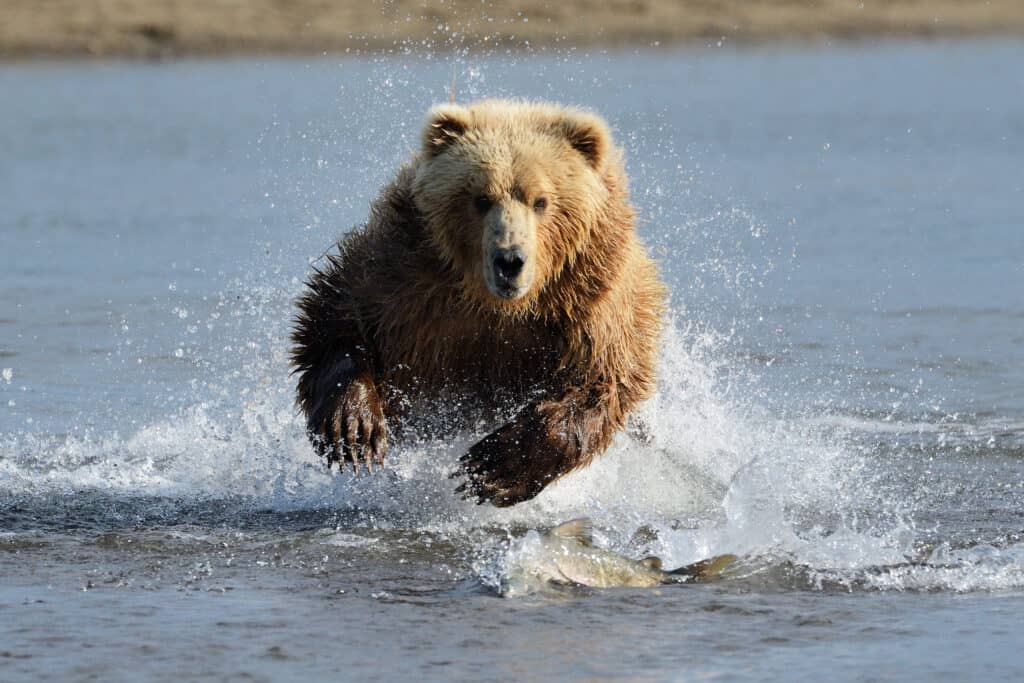
Grizzly bears hunt for fish in Yellowstone Lake.
©AndreAnita/Shutterstock.com
Wyoming is home to around 600 bears. Some of these bears live in Yellowstone National Park, which is largely located in Wyoming. The grizzly population of the Greater Yellowstone Ecosystem has gone from 136 bears in 1975 to an estimated 730 bears today. The number of females having cubs has remained stable since 1996, which means the bears may be at the right capacity for the park.
Summary of the Grizzly Bear Population by State:
Here’s a recap of the number of grizzlies found in the U.S.:
| State | Grizzly Bear Population |
|---|---|
| Alaska | 30,000 |
| Idaho | 80-100 |
| Montana | 1,800-2,000 |
| Washington | 500 |
| Wyoming | 600 |
How Many Grizzly Bear Attacks Happen Per Year?

In North America, there were 183 grizzly bear attacks on humans over a 15-year period.
©Jack Nevitt/Shutterstock.com
There’s no denying that grizzly bears are fearsome animals. Unfortunately, humans can come into danger when they encounter these bears in the wild. It may cause you to wonder–how many brown bear attacks happen per year? There are an average of 44 reported grizzly bear attacks worldwide per year.
In North America, there were 183 attacks over a 15-year period, while 291 occurred in Europe and 190 in Asia. From 2015-2022, there were a total of 15 fatalities in North America from grizzly attacks. But Europe leads with an average of 20 fatalities annually.
In over 50% of the cases, humans were engaged in leisure activities such as camping, fishing, hiking, or jogging. One-fourth of the victims of bear attacks were engaged in job-related activities like farming or logging. And 22% of attacks occurred during bear hunts. Data proves that most major bear attacks happen when a human accidentally engages a female grizzly who has cubs.
The photo featured at the top of this post is © DPS/Shutterstock.com
FAQs (Frequently Asked Questions)
Which state has the most grizzly bears?
Alaska has the most grizzlies by far. It has 30,000 and is the only state where they are not listed as endangered.
Why are there so few grizzlies in other states?
The main reasons are hunting and habitat loss. Grizzly bear populations were hunted to extinction in many states, and recovery has been difficult. Black bears were also hunted to near extinction, but their reintroduction has been successful in many parts of their former range. It isn’t clear why grizzly populations have struggled, but conservationists have some theories. Grizzly bears have stricter requirements for their habitats than the more adaptable brown bears. They also reproduce slowly and have only one to four cubs each year.
Are grizzlies dangerous?
They can be dangerous. They won’t go out of their way to attack humans, but there are documented cases of grizzly bears attacking hikers and other people who wander into their territory.
Thank you for reading! Have some feedback for us? Contact the AZ Animals editorial team.






